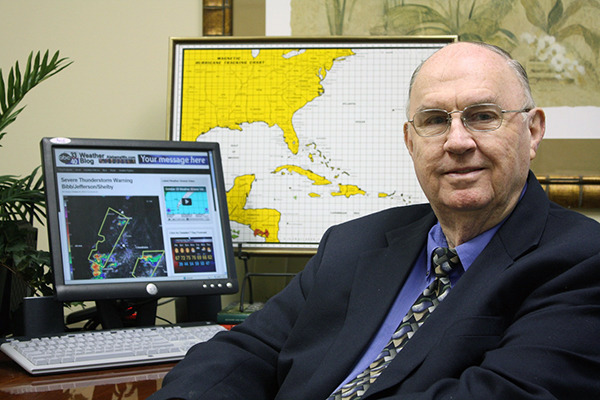How Do We Measure the Strength of a Tornado?
(credit: Meteorologist Ash Bray)
On May 20th, 2013, an EF5 tornado decimated the town of Moore, Oklahoma, killing twenty-four people and inflicting two billion in damages. The Moore tornado is estimated to have been over a mile wide in diameter, staying on the ground for forty minutes and traveling over fifteen miles. This disaster has left many wondering, to this day, how we can better predict these deadly acts of nature. The reality is, we still know very little about tornadoes.
The American Meteorological Society defines a tornado as a “violently rotating column of air, pendant from a cumuliform cloud or underneath a cumuliform cloud, and often (but not always) visible as a funnel cloud”. According to The National Oceanographic and Atmospheric Administration (NOAA), most tornadoes form from large, rotating thunderstorms known as supercells, which are a combination of these specified factors: instability, moisture, lift, and wind shear. Though the factors are known, no one really knows what magical combination of the aforementioned factors result in a tornado. The Storm Prediction Center, partnered with NOAA), report that numerous weather combinations can lead to tornadoes, but – and this is a bit crazy – the same combinations frequently fail to produce any tornadoes whatsoever. The only reliable way to know whether or not given weather conditions will produce a tornado is if one actually appears.
In addition to the tornado’s elusiveness, there’s also no timeframe as to how long or short a tornado’s lifespan may be. Generally, tornadoes die within a few minutes; the destructiveness behind the Moore tornado was due to its longer-than-average lifespan and higher-than-average wind speeds, topping out at 210mph, making it a monstrous EF5 tornado. A tornado’s strength is measured on what is now called the “Enhanced Fujita Scale”, taken from the simpler Fujita scale, (“F” Scale”), in 2007. This scale was created by Dr. Ted Fujita, a Japanese-born American meteorologist whose focus was on severe weather. He felt as though the Beaufort scale, which was a method back in 1805 that estimated wind speeds by studying how man-made objects behaved in a breeze, was inadequate and unable to properly measure a tornadoes strength. Beaufort’s scale begins at zero wind speed and ends with a hurricane, which is defined as, “…maximum sustained winds reaching seventy-four miles per hour”, according to NOAA.
Dr. Fujita was well aware of other empirical measurements capable between seventy-four miles per hour and the speed of sound, (seven-hundred and sixty miles per hour). He also knew that these measurements would be imperative in measuring a tornado’s destruction. Fujita published a paper in 1971 entitled “Proposed Characterization of Tornadoes and Hurricanes by Area and Intensity”, using results from a three-year study of tornadoes funded by NASA. His paper laid out the basic proposal of the “F” scale: estimating the peak wind speeds of a severe storm by categorizing the damage that is left behind. This scale ranged from an F1 all the way up to an F12, which theoretically would pack winds equivalent to the speed of sound, (though never seen on Earth, winds to this magnitude are common on the planet Neptune).
As with any great idea, there tend to be flaws: It was based on observation, not measurement. Tornadoes are exceptionally destructive; normal weather instruments were incapable of operating, let alone surviving a tornado. Tornadoes are also incredibly unpredictable, making it near impossible to deploy a sturdier instrument in its path. Another issue being that this scale did not take the multitude of varying building materials into consideration: a sturdy home could withstand the winds of a small tornado whereas a mobile home would more than likely be flipped over. Lastly, the scale did not account for time. A brief, rapidly moving storm with excessive winds could actually cause less damage than a slow-moving, long-lasting storm with exponentially slower wind speeds. Realizing these issues, scientists from Texas Tech University suggested changes to the Fujita Scale, coining the Enhanced Fujita Scale. This newly enhanced scale featured tornado damage assessed by meteorologists and engineers across twenty-eight different types of building materials and natural structures. The horrific damage inflicted upon buildings like Briarwood Elementary School, as well as the loss of numerous single-family homes, enabled scientists to originally categorize the Moore tornado as an “EF5”. The Enhanced Fujita Scale came into play in the year 2007, and is now the only true way to judge the impact of a tornado – at least on a physical level.
©2018 Meteorologist Ash Bray
To learn more about other informative educational topics in meteorology, be sure to click here!
AlabamaWX is pleased to partner with the Global Weather and Climate Center team for outstanding posts about our atmosphere. Visit them at https://www.globalweatherclimatecenter.com for more great information!
Category: Partner News Stories

















